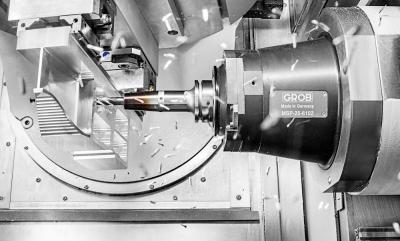
Grob Systems offers its G-Series universal mill/turn machining centers. The G-Series, which includes the G350, G550 and G750 5-axis universal machining centers, offers limitless possibilities for milling parts made of the most diverse materials.
They are suitable for the aerospace industry, where complex components with high cutting volumes need to be achieved. Each machining center features a compact design, maximum milling performance, high visibility and optimized work area access.
The Access-Series, featuring basic models G350a and G550a, include more features than ever before, which are backed by Grob’s more than 90 years of experience with machine tools. These 5-axis universal machining centers have short payback time, yet still deliver the best machining quality for production facility. They are rated for optimized reliability, high productivity and modular expandability for automation solutions. The machines have a rigid spindle axis, efficient machine cooling and a unique overhead function with excellent chip fall and reduced thermal load in the component.
The universal mill/turn machining centers can complete machining of a part by milling and turning in a single clamping, thereby saving time, space and investment.
Contact Details
Related Glossary Terms
- centers
centers
Cone-shaped pins that support a workpiece by one or two ends during machining. The centers fit into holes drilled in the workpiece ends. Centers that turn with the workpiece are called “live” centers; those that do not are called “dead” centers.
- gang cutting ( milling)
gang cutting ( milling)
Machining with several cutters mounted on a single arbor, generally for simultaneous cutting.
- machining center
machining center
CNC machine tool capable of drilling, reaming, tapping, milling and boring. Normally comes with an automatic toolchanger. See automatic toolchanger.
- milling
milling
Machining operation in which metal or other material is removed by applying power to a rotating cutter. In vertical milling, the cutting tool is mounted vertically on the spindle. In horizontal milling, the cutting tool is mounted horizontally, either directly on the spindle or on an arbor. Horizontal milling is further broken down into conventional milling, where the cutter rotates opposite the direction of feed, or “up” into the workpiece; and climb milling, where the cutter rotates in the direction of feed, or “down” into the workpiece. Milling operations include plane or surface milling, endmilling, facemilling, angle milling, form milling and profiling.
- turning
turning
Workpiece is held in a chuck, mounted on a face plate or secured between centers and rotated while a cutting tool, normally a single-point tool, is fed into it along its periphery or across its end or face. Takes the form of straight turning (cutting along the periphery of the workpiece); taper turning (creating a taper); step turning (turning different-size diameters on the same work); chamfering (beveling an edge or shoulder); facing (cutting on an end); turning threads (usually external but can be internal); roughing (high-volume metal removal); and finishing (final light cuts). Performed on lathes, turning centers, chucking machines, automatic screw machines and similar machines.
